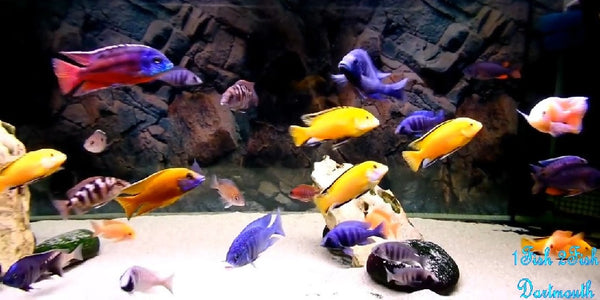

The adorable yellow cichlid is a terrific choice for beginners. Electric Yellow Cichlid Image Credit: hrohmann, Pixabay They don’t get very large, reaching up to 3 inches, requiring only a 30-gallon tank.Ĥ. They can also be somewhat aggressive and may not work in all aquarium situations. These fish aren’t the hardiest, meaning they are ultra-sensitive and difficult to keep. If you’ve been in the fish game for a while, caring for the electric blue Johanni is a challenge you might be up for. Electric Blue Johanni Image Credit: Darko Cvetanoski, Shutterstock They can be moderately aggressive with other tankmates, but beginners are welcome to take a stab at owning one of these blue beauties.ģ. These fish can reach almost 8 inches in captivity. The electric blue hap has a tremendously unique color, adding a splash of personality to any aquarium.

Electric Blue Hap Image Credit: Vojce, Shutterstock These fish can be many colors on the spectrum, which can even change depending on their mood.Ģ. These cichlids grow up to 4 inches in nature, but they’ve been known to grow larger in captivity. Otherwise known as the Cynotilapia afra, the dogtooth cichlid is a small species native to Lake Malawi. Dogtooth Cichlid Image Credit: Trybex, Shutterstock So, make sure your skill set matches their needs before you buy.

Some can be very finicky, aggressive, and otherwise hard to keep. If you’re thinking of adding a cichlid or two, here are 40 species that can work well in your aquarium if you offer the right conditions. They have become popular amongst aquarists because of their incredible personality differences, color variations, and environmental needs. But you can find them in other places too, like Madagascar, southern Asia, and even tropical parts of the Americas. Breeding pairs are often aggressive to all other fish.There are over 1,300 species of cichlids-most of which dwell in Lake Malawi in Africa. Social behaviour: Loosely social until sexual maturity.A variety of high-quality dry, frozen, and live meaty foods is necessary for optimal health and coloration. Minimum tank size: 40 gallons for an adult pair.Compatible with other species in a spacious tank.The front part of these fins are soft and perfect for precise positions and effortless movements in the water as opposed to fast swimming. Cichlids have spiny rays in the back parts of the anal, dorsal, pectoral, and pelvic fins to help discourage predators. Sometimes the females can be a pink colouring with a hint of the blue on their sides.Īll cichlids share a common feature that some saltwater fish such as wrasses and parrotfish have and that is a well-developed pharyngeal set of teeth that are in the throat, along with their regular teeth. Females are a drab colour of brown-gray, with slightly more obvious vertical bars.

This colouring makes them easy to identify. The dorsal fin and the top half of the tail fin are orange and there are several egg spots on their anal fin. Males have an overall ice blue colour with very faded vertical bars on the body. The males are more colourful than the females. Do not house with fish of the same colour and shape though, as the male will look at these others as trespassers and attack them. It is not a community tank specimen to be kept with fish other than cichlids, but it can be kept in a tank with similarly tempered Mbunas. The Pseudotropheus Ice Blue is only moderately aggressive compared to other Mbuna. It makes a great fish to add variety in a Mbuna cichlid Tank. It has a very appealing coloration of an ice blue body contrasted with a bright orange top fin. The Pseudotropheus Ice Blue Maylandia greshakei, also known as William's Mbuna, is a pretty zebra-type cichlid from Lake Malawi, Africa.


 0 kommentar(er)
0 kommentar(er)
